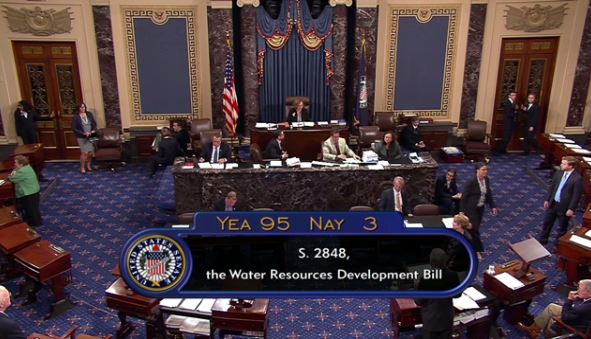 In a major victory for ASCE and other infrastructure stakeholders (i.e. everyone!) the Senate on Thursday passed S.2848 the Water Resources Development Act of 2016 in a vote of 95-3. In many ways, passing the bill should be a no-brainer, as WRDA will increase America’s competitiveness by preparing ports and harbors for post-Panama Canal renovation sized ships, establish a long-awaited dam rehabilitation program and authorize major ecosystem restoration projects across dozens of states. However, in an era of tightening federal budgets, partisan deadlock and election-year rhetoric many are calling WRDA’s passage no small miracle. It’s difficult to find any bill pass with such favorability, let alone a multibillion dollar one.
In a major victory for ASCE and other infrastructure stakeholders (i.e. everyone!) the Senate on Thursday passed S.2848 the Water Resources Development Act of 2016 in a vote of 95-3. In many ways, passing the bill should be a no-brainer, as WRDA will increase America’s competitiveness by preparing ports and harbors for post-Panama Canal renovation sized ships, establish a long-awaited dam rehabilitation program and authorize major ecosystem restoration projects across dozens of states. However, in an era of tightening federal budgets, partisan deadlock and election-year rhetoric many are calling WRDA’s passage no small miracle. It’s difficult to find any bill pass with such favorability, let alone a multibillion dollar one.
WRDA is now the legislative envy of other bill in town—bringing together two of the Senate’s arguably most polar opposite personalities—Jim Inhofe (R-OK) and Barbara Boxer (D-CA), who’ve made the case on just how important flood control, navigation and ecosystem restoration are to communities around the county. It also helps that the Congressional Budget Office predicts that while the bill “costs” nearly $10 billion, it will actually save the U.S. taxpayer $6 million dollars over ten years. Presumably, that has something to do with risk mitigation and maintenance activities the bill provides, allowing engineers to get ahead of problems before unscheduled delays or infrastructure failures stack up.
Included in the final bill are several programs ASCE has worked for decades to pass. A dam rehabilitation program housed under the Federal Emergency Management Agency (FEMA) will allow nonfederal dam owners to apply for small grants to rehabilitate, remove or repair high hazard dams. There’s also several provisions to assist communities in upgrading their drinking water and wastewater systems, including assistance for Flint, Michigan to help recover from the lead contamination the community suffered last year. The legislation authorizes 27 new projects at the Army Corps of Engineers, 30 new feasibility studies and modernizes several new projects already underway.
In April the House passed a much narrower bill, mostly focused on Army Corps Chief’s Reports and feasibility studies. The House Transportation & Infrastructure Committee held an updated hearing on their bill Thursday and are expected to begin full consideration of the bill next week and pass a bill before returning home in October. The hope is while Congress is home for election campaigning, the difference of the bills can be reconciled and prepared for quick passage in December.
Leave a Reply








Just from reading this news report it indicates to me that there will be little or no money to help California Counties and Cities to upgrade their storm drain or sewer systems. Los Angeles still relies on brick sewers and cities located in Southern California watershed depend on drainage system that were developed decades ago before the rise of urban style living began. The unfortunate situation for southern California is that municipalities forget that it rains and when it does rain the flooding is always blamed on God delivering too much rain. More money would be saved if engineering solutions are applied to increase the capabilities of existing systems.